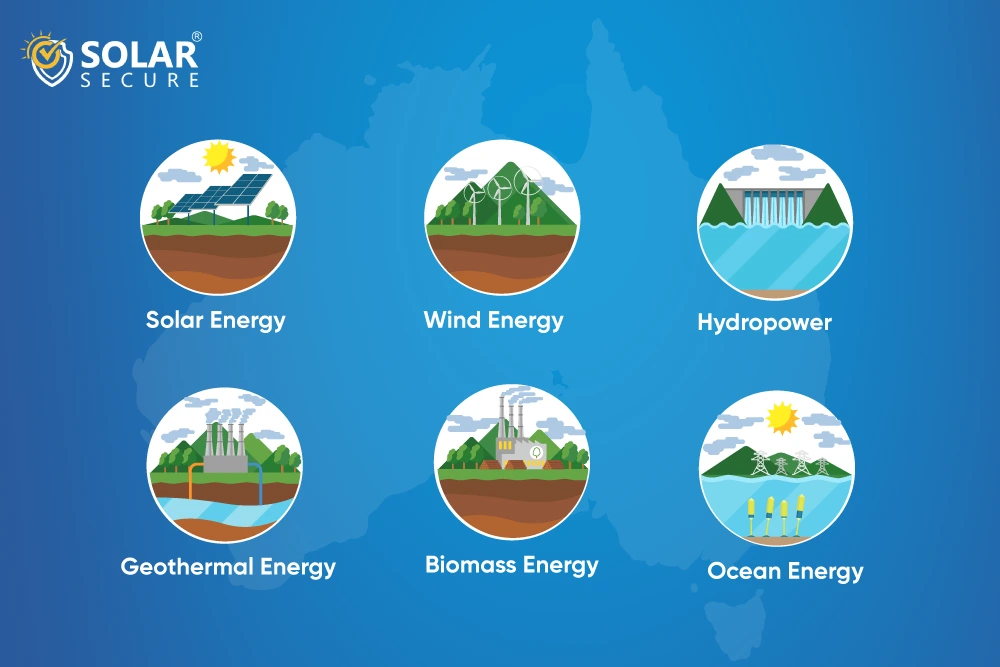We all dream of a cleaner, greener world where energy flows steadily, no longer at the mercy of weather and similar disruptions. But is this ideal future within reach?
It is. By tapping into the distinct strengths of different renewable sources in partnership with solar energy, we can build an energy system that is robust, efficient, and reliable. This perfect synergy optimizes resource use, bringing about economic strength and numerous environmental benefits.
Let’s take a closer look at how the integration of solar and other renewables is shaping a sustainable future for all of us.
Harnessing Solar Energy: How Sunlight Fuels Our Future
Solar energy refers to the power we extract from the sun’s rays. Solar panels, made with silicon semiconductors arranged in two layers, capture this energy.
When sunlight strikes the panels, an electric field forms between the positive and negative layers, causing electrons to move and generate electricity.
Advantages and Benefits of Solar Power
For homeowners in Australia, the country’s plentiful sunshine is a major asset. Increasingly, Australians are turning to solar energy to power their homes while supporting a cleaner, greener environment.
Solar energy offers numerous advantages, including energy independence, lower electricity bills, and minimal maintenance costs. Importantly, it also helps reduce our carbon footprint and combat climate change.
On the downside, solar systems require substantial space and a significant upfront investment. Plus, integrating backup systems like solar batteries can be costly, particularly for those with limited incomes.
Since solar energy relies solely on sunlight, ensuring a consistent power supply during overcast weather remains a key challenge. Interested in how these obstacles can be addressed? Explore the next section to learn more!
A Closer Look at Alternative Renewable Energy Sources
Natural resources that renew themselves quickly and generate minimal or zero carbon emissions are the foundation of renewable energy. These sources are vital for combating climate issues.
Along with solar energy, wind, hydropower, geothermal, biomass, and ocean energy are prominent examples of renewable energy.
Wind Energy
The kinetic energy of the wind is converted into electricity through the use of wind turbines. These turbines capture energy from the moving air with their rotating blades.
As the blades spin, they drive a rotor connected to a generator, which then produces electrical power and supplies it to the national grid. Wind turbines are commonly found offshore, where strong and steady winds prevail, and they must be maintained regularly.
Hydropower
The kinetic energy of flowing water is harnessed in hydropower systems, typically from reservoirs or running river plants.
Water descending from higher to lower elevations drives turbines, producing electricity that powers homes.
Hydropower reservoirs also play important roles in supplying drinking water, preventing floods and droughts, and supporting agricultural irrigation.
Geothermal Energy
Sourced from the Earth's inner heat, geothermal energy is a reliable and sustainable form of power.
The intense heat from the Earth's core rises toward the surface, often manifesting as steam from heated underground water. This steam spins turbines to create electricity.
Geothermal energy is harnessed through three types of plants: dry steam, flash steam, and binary cycle systems. Besides electricity generation, it also helps warm homes, dry crops, and support greenhouse agriculture in cooler climates.
Biomass Energy
Biomass energy is produced from organic substances, including animal and plant waste. These materials can be burned for direct heat or converted into biofuels such as ethanol and biodiesel. It remains a popular energy source in rural communities and developing nations, where it is used for daily activities like cooking, heating, and lighting. While biomass does emit greenhouse gases, its emissions are far lower than those from fossil fuels like coal, oil, and gas.
Ocean Energy
Among Australia’s renewable energy options, ocean energy is still emerging and needs more advanced technology to become economically viable.
Ocean energy is harvested from the natural energy found in ocean waters and includes types such as tidal energy, wave energy, salinity gradient energy, and ocean thermal energy.
It works by capturing kinetic energy from wave motion and tidal flows, while thermal energy systems utilize the temperature differences between surface and deep waters to create electricity or heat.
Can Blending Solar with Other Renewables Make Australia's Energy Supply More Reliable?
Combining solar power with other energy sources is a great strategy for ensuring a reliable energy supply in Australia. This integration helps address the intermittency of solar energy, providing a steady flow of power even when sunlight is scarce.
But is it just about achieving energy independence?
Not at all! It also offers extra advantages, such as boosting Australia’s environmental sustainability, reducing costs, and supporting the grid. Integrating solar with other renewables isn’t a complex task. With a clear understanding of your energy needs and by selecting the right renewable sources, you can create a well-structured energy system.
Let’s dive into the significance and advantages of integrating solar energy with other renewable sources in the next section.
7 Ways Solar and Other Renewable Energy Sources Work Together for Greater Benefits
With Australia’s population steadily increasing, energy demand is rising rapidly. To meet this need, we can diversify our energy sources and develop a strong backup strategy to ensure our homes remain powered, even during unexpected issues.
Learn how integrating solar energy with other renewables promotes energy independence, combats climate change, and secures a cleaner, more resilient energy future.
Here’s a list that explores the advantages of combining solar energy with other renewable sources.
Enhance Overall Energy Generation
If your household needs more energy to operate effectively, one energy source might not meet the demand. That’s when integrating several renewable energy sources offers a stronger and more consistent energy solution.
Optimize System Performance
Each renewable source has specific times when it produces the most energy. Integrating multiple sources helps maximize overall energy production. For example, solar power is most effective on bright, sunny days, while wind energy works best in windy conditions. By combining both, you can generate more energy, thereby improving overall efficiency.
Decreased Environmental Harm
The integration of multiple renewable sources plays a major role in cutting carbon emissions and reducing environmental harm. It contributes to better air quality, mitigates the effects of climate change, and promotes ecosystem balance with its sustainable energy output.
Deliver Improved Energy Independence and Economic Rewards
Through energy integration, you can achieve greater self-reliance while decreasing dependence on external energy supplies. This approach brings significant economic benefits and helps lower expenses.
By producing your own power, you become less susceptible to disruptions and fluctuations in the broader energy supply chain.
Community Participation and Regional Benefits
With the adoption of mixed and hybrid energy systems, local communities now enjoy greater control over their energy resources, leading to increased energy independence and flexibility.
This shift enhances energy security and raises awareness about Australia's energy efficiency. Through community solar projects, residents can also explore advanced renewable technologies and collaborate in building a more sustainable future.
Provides Versatility and Strong Adaptability
A diversified renewable energy system can respond to changes more swiftly and effectively than a single-source setup.
For instance, when new solar technology launches and you plan to upgrade, your combined system ensures continuous energy supply while the solar component undergoes maintenance or enhancements.
Strengthened Grid Stability and Better Integration
Integrating solar energy with other renewable sources strengthens the power supply, reducing the chances of frequent outages. It also eases the load on the grid and helps maintain a stable balance between energy supply and consumer demand.
Breakthrough Technologies Supporting Solar Integration with Other Renewable Sources in 2025
As we step into 2025, many Australians are choosing rooftop solar to lower their electricity bills and lead more sustainable lives. But in addition to solar, integrating multiple renewable energy sources can fuel significant advancements in efficiency, system integration, and energy storage technologies, including longer-lasting solar batteries.
With innovations like smart microgrids, Vertical Axis Wind Turbines (VAWTs), Pumped Hydro Storage, Hydrokinetic turbines, electric vehicles, floating solar arrays, BIPV systems, and advanced battery storage solutions, the future of renewable energy integration shines brighter than ever. Embrace these technological breakthroughs today and join the journey toward building a clean, green, and sustainable tomorrow.
For quality solar products, contact Solar Secure today and get your free solar quote!
Conclusion
Integrating solar energy with other renewable sources like wind, hydro, and biomass is more than just a smart energy strategy, it’s a powerful pathway towards a resilient, sustainable future. By combining the strengths of various renewables, we can overcome the natural variability of each individual source, ensuring a more reliable and consistent energy supply. This hybrid approach not only maximizes resource utilization but also enhances grid stability, reduces dependence on fossil fuels, and minimizes the overall carbon footprint.
Moreover, diversified renewable systems can be tailored to meet the specific environmental and economic needs of different regions, fostering local energy independence and driving economic growth. Technological advancements in energy storage, smart grids, and predictive analytics further amplify the benefits, making integrated renewable systems more efficient and accessible than ever before.
Ultimately, the synergy of solar with other renewables offers a compelling solution for achieving global climate goals, supporting energy equity, and creating a cleaner, greener world for future generations. Embracing this integrated model is not just a choice, it’s an essential step forward in the global transition to sustainable energy.






